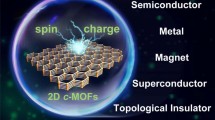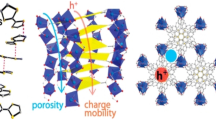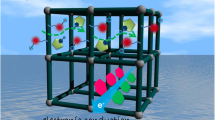Abstract
Two-dimensional (2D) metal–organic frameworks (MOFs) belong to a subgroup of MOFs reminiscent of graphite and covalent organic frameworks (COFs). In the past decade, conductive 2D MOFs have received increasing attention due to their relatively high charge carrier mobility and low resistivity that originate from in-plane charge delocalization and extended π conjugation within the layers. This review comprises the current state-of-the-art of the representative progress in theoretical exploration and electronic applications of conductive 2D MOFs. Special emphasis is placed on the intrinsic relations between the structural factors and the electronic properties of conductive 2D MOFs. This review will provide guidance for researchers to design and synthesize conductive 2D MOFs for advanced applications.




Reprinted with permission from [60]. Copyright 2013 Macmillan Publishers Limited

Reprinted with permission from [61]. Copyright 2015 Owner Societies


Reprinted with permission from [64]. Copyright 2018 American Chemical Society

Reprinted with permission from [65]. Copyright 2017 The Royal Society of Chemistry

Reprinted with permission from [44]. Copyright 2012 American Chemical Society

Reprinted with permission from [69]. Copyright 2017 American Chemical Society

Reprinted with permission from [62]. Copyright 2014 American Chemical Society

Reprinted with permission from [78]. Copyright 2014 American Chemical Society

Reprinted with permission from [88]. Copyright 2017 American Chemical Society
Similar content being viewed by others
References
Furukawa H, Cordova KE, O’Keeffe M, Yaghi OM (2013) The chemistry and applications of metal–organic frameworks. Science 341:947
Zhou HC, Long JR, Yaghi OM (2012) Introduction to metal–organic frameworks. Chem Rev 112:673–674
Hirai K, Reboul J, Morone N et al (2014) Diffusion-coupled molecular assembly: structuring of coordination polymers across multiple length scales. J Am Chem Soc 136:14966–14973
Lu W, Wei Z, Gu ZY et al (2014) Tuning the structure and function of metal–organic frameworks via linker design. Chem Soc Rev 43:5561–5593
Zhou HC, Kitagawa S (2014) Metal–organic frameworks (MOFs). Chem Soc Rev 43:5415–5418
Nandasiri MI, Jambovane SR, McGrail BP et al (2016) Adsorption, separation, and catalytic properties of densified metal–organic frameworks. Coord Chem Rev 31:38–52
Li B, Wen HM, Cui Y et al (2016) Emerging multifunctional metal–organic framework materials. Adv Mater 28:8819–8860
Cui Y, Li B, He H et al (2016) Metal–organic frameworks as platforms for functional materials. Acc Chem Res 49:483–493
Lei J, Qian R, Ling P et al (2014) Design and sensing applications of metal–organic framework composites. Trend Anal Chem 58:71–78
Cui L, Wu J, Li J, Ju H (2015) Electrochemical sensor for lead cation sensitized with a DNA functionalized porphyrinic metal–organic framework. Anal Chem 87:10635
Liang K, Ricco R, Doherty CM et al (2015) Biomimetic mineralization of metal–organic frameworks as protective coatings for biomacromolecules. Nat Commun 6:7240
Hintz H, Wuttke S (2014) Postsynthetic modification of an amino-tagged MOF using peptide coupling reagents: a comparative study. Chem Commun 50:11472–11475
Mehta J, Bhardwaj N, Bhardwaj SK et al (2016) Recent advances in enzyme immobilization techniques: metal–organic frameworks as novel substrates. Coord Chem Rev 322:30–40
Cai H, Huang YL, Li D (2019) Biological metal–organic frameworks: structures, host–guest chemistry and bio-applications. Coord Chem Rev 378:207–221
Liu X, Qi W, Wang Y et al (2017) A facile strategy for enzyme immobilization with highly stable hierarchically porous metal–organic frameworks. Nanoscale 9:17561–17570
Liang K, Richardson JJ, Cui J et al (2016) Metal–organic framework coatings as cytoprotective exoskeletons for living cells. Adv Mater 28:7910–7914
Suh PM, Park JH, Prasad KT et al (2012) Hydrogen storage in metal–organic frameworks. Chem Rev 112:782–835
Mason JA, Oktawiec J, Taylor MK et al (2015) Methane storage in flexible metal–organic frameworks with intrinsic thermal management. Nature 527:357–361
Peng YL, Pham T, Zaworotko MJ et al (2018) Robust ultramicroporous metal–organic frameworks with benchmark affinity for acetylene. Angew Chem Int Ed 57:10971–10975
Lee J, Farha OK, Roberts J et al (2009) Metal–organic framework materials as catalysts. Chem Soc Rev 38:1450–1459
Drout RJ, Robison L, Farha OK (2019) Catalytic applications of enzymes encapsulated in metal–organic frameworks. Coord Chem Rev 381:151–160
Navarro-Sanchez J, Almora-Barrios N, Lerma-Berlanga B et al (2019) Translocation of enzymes into a mesoporous MOF for enhanced catalytic activity under extreme conditions. Chem Sci 10:4082–4088
Kreno LE, Leong K, Farha OK et al (2012) Metal–organic framework materials as chemical sensors. Chem Rev 112:1105–1125
Kempahanumakkagari S, Kumar V, Samaddar P et al (2018) Biomolecule-embedded metal–organic frameworks as an innovative sensing platform. Biotechnol Adv 36:467–481
Qiu Q, Chen H, Wang Y, Ying Y (2019) Recent advances in the rational synthesis and sensing applications of metal–organic framework biocomposites. Coord Chem Rev 387:60–78
Downes AC, Marinescu CS (2017) Electrocatalytic metal–organic frameworks for energy application. ChemSusChem 10:4374–4392
Ko M, Mendecki L, Mirica KA et al (2018) Conductive two-dimensional metal–organic frameworks as multifunctional materials. Chem Commun 54:7873–7891
O’Keeffe M, Yaghi OM (2012) Deconstructing the crystal structures of metal–organic frameworks and related materials into their underlying nets. Chem Rev 112:675–702
Li JR, Sculley J, Zhou HC (2012) Metal–organic frameworks for separations. Chem Rev 112:869–932
Liao FS, Lo WS, Hsu WS et al (2017) Shielding against unfolding by embedding enzymes in metal–organic frameworks via a de novo approach. J Am Chem Soc 139:6530–6533
He C, Lu K, Liu D, Lin W (2014) Nanoscale metal–organic frameworks for the co-delivery of cisplatin and pooled siRNAs to enhance therapeutic efficacy in drug-resistant ovarian cancer cells. J Am Chem Soc 136:5181–5184
Wuttke S, Braig S, Preiss T et al (2015) MOF nanoparticles coated by lipid bilayers and their uptake by cancer cells. Chem Commun 51:15752–15755
Navarro-Sanchez J, Argente-Garcia AI, Moliner-Martinez Y et al (2017) Peptide metal–organic frameworks for enantioselective separation of chiral drugs. J Am Chem Soc 139:4294–4297
Ren Z, Luo J, Wan Y (2018) Highly permeable biocatalytic membrane prepared by 3D modification: metal–organic frameworks ameliorate its stability for micropollutants removal. Chem Eng J 348:389–398
Sakamoto R, Hoshiko K, Liu Q (2015) A photofunctional bottom-up bis(dipyrrinato)zinc(II) complex nanosheet. Nat Commun 6:6713
Sakamoto R, Yagi T, Hoshiko K (2017) Photofunctionality in porphyrin-hybridized bis(dipyrrinato)zinc(II) complex micro- and nanosheets. Angew Chem Int Ed 56:3526–3530
Liu YR, Sakamoto R, Ho CL (2019) Electrochromic triphenylamine-based cobalt(II) complex nanosheets. J Mater Chem C 7:9159–9166
Sun L, Campbell MG, Dinca M (2016) Electrically conductive porous metal–organic frameworks. Angew Chem Int Ed 55:3566–3579
Cao L, Wang T, Wang C (2018) Synthetic strategies for constructing two-dimensional metal organic layers (MOLs): a tutorial review. Chin J Chem 36:754–764
Tan C, Cao X, Wu XJ et al (2017) Recent advances in ultrathin two-dimensional nanomaterials. Chem Rev 117:6225–6331
Li PZ, Maed Y, Xu Q (2011) Top-down fabrication of crystalline metal–organic framework nanosheets. Chem Commun 47:8436–8438
Amo Ochoa P, Welte L, González Prieto R et al (2010) Single layers of a multifunctional laminar Cu(I,II) coordination polymer. Chem Commun 46:3262–3264
Saines PJ, Steinmann M, Tan JC et al (2012) Isomer-directed structural diversity and its effect on the nanosheet exfoliation and magnetic properties of 2,3-dimethylsuccinate hybrid frameworks. Inorg Chem 51:11198–11209
Hmadeh M, Lu Z, Yaghi OM (2012) New porous crystals of extended metal-catecholates. Chem Mater 24:3511–3513
Wang ZF, Yao MY, Ming WM et al (2013) Creation of helical Dirac fermions by interfacing two gapped systems of ordinary fermions. Nat Commun 4:1384
Zhao B, Zhang JY, Feng WX et al (2014) Quantum spin Hall and Z2 metallic states in an organic material. Phys Rev B Condens Matter Mater Phys 90:201403
Dong L, Kim Y, Er D et al (2017) Two-dimensional π-conjugated covalent-organic frameworks as quantum anomalous hall topological insulators. Phys Rev Lett 116:096601
Wu MH, Wang ZJ, Liu JW et al (2016) Conetronics in 2D metal–organic frameworks: double/half Dirac cones and quantum anomalous Hall effect. 2D Mater 4:015015
Yamada MG, Soejima T, Tsuji N et al (2016) First-principles design of a half-filled flat band of the kagome lattice in two-dimensional metal–organic frameworks. Phys Rev B 94:081102
Kane CL, Mele EJ (2005) Quantum spin Hall effect in graphene. Phys Rev Lett 95:226801
Fu L, Kane CL (2007) Topological insulators with inversion symmetry. Phys Rev B 76:045302
Bernevig BA, Hughes TL, Zhang SC (2006) Quantum spin Hall effect and topological phase transition in HgTe quantum wells. Science 314:1757–1761
König M, Wiedmann S, Brüne C et al (2007) Quantum spin Hall insulator state in HgTe quantum wells. Science 318:766–770
Hsieh D, Qian D, Wray L et al (2008) A topological Dirac insulator in a quantum spin Hall phase. Nature 452:970–974
Xia Y, Qian D, Hsieh D et al (2009) Observation of a large-gap topological-insulator class with a single Dirac cone on the surface. Nat Phys 5:398–402
Zhang HJ, Liu CX, Qi XL et al (2009) Topological insulators in Bi2Se3, Bi2Te3 and Sb2Te3 with a single Dirac cone on the surface. Nat Phys 5:438–442
Chen YL, Analytis JG, Chu JH et al (2009) Experimental realization of a three-dimensional topological insulator, Bi2Te3. Science 325:178–181
Zhang X, Zhang HJ, Wang J et al (2012) Actinide topological insulator materials with strong interaction. Science 335:1464–1466
Wang ZF, Su NH, Liu F (2013) Prediction of a two-dimensional organic topological insulator. Nano Lett 13:2842–2845
Wang ZF, Liu Z, Liu F (2013) Organic topological insulators in organometallic lattices. Nat Commun 4:1471
Chen S, Dai J, Zeng XC (2015) Metal–organic kagome lattices M3(2,3,6,7,10,11-hexaiminotriphenylene)2 (M = Ni and Cu): from semiconducting to metallic by metal substitution. Phys Chem Chem Phys 17:5954–5958
Sheberla D, Sun L, Blood-Forsythe AM et al (2014) High electrical conductivity in Ni3(2,3,6,7,10,11-hexaiminotriphenylene)2, a semiconducting metal–organic graphene analogue. J Am Chem Soc 136:8859–8862
Foster EM, Sohlberg K, Spataru DC (2016) Proposed modification of the graphene analogue Ni3(HITP)2 to yield a semiconducting material. J Phys Chem C 120:15001–15008
Foster EM, Sohlberg K, Allendorf DM et al (2018) Unraveling the semiconducting/metallic discrepancy in Ni3(HITP)2. J Phys Chem Lett 9:481–486
Li W, Sun L, Qi JS et al (2017) High temperature ferromagnetism in π-conjugated two-dimensional metal–organic frameworks. Chem Sci 8:2859–2867
Zeng MH, Wang QX, Tan YX et al (2010) Rigid pillars and double walls in a porous metal–organic framework: single-crystal to single-crystal, controlled uptake and release of iodine and electrical conductivity. J Am Chem Soc 132:2561–2563
Mendecki L, Mirica AK (2018) Conductive metal–organic frameworks as ion-to-electron transducers in potentiometric sensors. ACS Appl Mater Interfaces 10:19248–19257
Lahiri N, Lotfizadeh N, Tsuchikawa R et al (2017) Hexaaminobenzene as a building block for a family of 2D coordination polymers. J Am Chem Soc 139:19–22
Dou JH, Sun L, Ge TC et al (2017) Signature of metallic behavior in the metal–organic frameworks M3(hexaiminobenzene)2 (M = Ni, Cu). J Am Chem Soc 139:13608–13611
Chen B, Xiang S, Qian G (2010) Metal–organic frameworks with functional pores for recognition of small molecules. Acc Chem Res 43(8):1115–1124
Wu GD, Huang JH, Zan Y et al (2016) Porous field-effect transistors based on a semiconductive metal–organic framework. J Am Chem Soc 139:1360–1363
Larcher D, Tarascon JM (2014) Towards greener and more sustainable batteries for electrical energy storage. Nat Chem 7:19–29
Sheberla D, Bachman CJ, Elias SJ et al (2017) Conductive MOF electrodes for stable super capacitors with high areal capacitance. Nat Mater 16:220–224
Gu W, Yushin G (2014) Review of nanostructured carbon materials for electrochemical capacitor applications: advantages and limitations of activated carbon, carbide-derived carbon, zeolite-templated carbon, carbon aerogels, carbon nanotubes, onion-like carbon, and graphene. Wiley Interdiscip Rev Energy Environ 3:424–473
Campbell GM, Sheberla D, Liu FS et al (2015) Cu3(hexaiminotriphenylene)2: an electrically conductive 2D metal–organic framework for chemiresistive sensing. Angew Chem Int Ed 54:4349–4352
Campbell GM, Liu FS, Swager MT et al (2015) Chemiresistive sensor arrays from conductive 2D metal–organic frameworks. J Am Chem Soc 137:13780–13783
Kambe T, Sakamoto R, Hoshiko K et al (2013) π-conjugated nickel bis(dithiolene) complex nanosheet. J Am Chem Soc 135:2462–2465
Kambe T, Sakamoto R, Kusamoto T et al (2014) Redox control and high conductivity of nickel bis(dithiolene) complex π-nanosheet: a potential organic two-dimensional topological insulator. J Am Chem Soc 136:14357–14360
Coronado E, Mascaros JR, Garcia CJ (2000) Coexistence of ferromagnetism and metallic conductivity in a molecule-based layered compound. Nature 408:447–449
Givaja G, Amo-Ochoa P, Garcıa CJ (2012) Electrical conductive coordination polymers. Chem Soc Rev 41:115–147
Low KH, Roy VAL, Chui SS (2010) Highly conducting two-dimensional copper(I) 4-hydroxythiophenolate network. Chem Commun 46:7328–7330
Cui JS, Xu ZT (2014) An electroactive porous network from covalent metal–dithiolene links. Chem Commun 50:3986–3988
Takaishi S, Hosoda M, Kajiwara T et al (2010) Electroconductive porous coordination polymer Cu[Cu(pdt)2] composed of donor and acceptor building units. Inorg Chem 48:9048–9050
Kobayashi Y, Jacobs B, Allendorf DM et al (2010) Conductivity, doping, and redox chemistry of a microporous dithiolene-based metal–organic framework. Chem Mater 22:4120–4122
McNamara WR, Han Z, Alperin PJ (2011) A cobalt–dithiolene complex for the photocatalytic and electrocatalytic reduction of protons. J Am Chem Soc 133:15368–15371
Han ZJ, Eisenberg R (2014) Fuel from water: the photochemical generation of hydrogen from water. Acc Chem Res 247:2537–2544
Clough JA, Yoo WJ, Mecklenburg HM, Marinescu SC (2015) Two-dimensional metal–organic surfaces for efficient hydrogen evolution from water. J Am Chem Soc 137:118–121
Clough JA, Skelton MJ, Downes AC et al (2017) Metallic conductivity in a two-dimensional cobalt dithiolene metal–organic framework. J Am Chem Soc 139:10863–10867
Acknowledgements
The authors acknowledge the financial support from National Natural Science Foundation of China (21601093) and 111 Project (B12015).
Author information
Authors and Affiliations
Corresponding author
Additional information
Publisher's Note
Springer Nature remains neutral with regard to jurisdictional claims in published maps and institutional affiliations.
This article is part of the Topical Collection “Metal–Organic Framework: From Design to Applications” edited by Xian-He Bu, Michael J. Zaworotko, and Zhenjie Zhang.
Rights and permissions
About this article
Cite this article
Gao, J., Geng, S., Chen, Y. et al. Theoretical Exploration and Electronic Applications of Conductive Two-Dimensional Metal–Organic Frameworks. Top Curr Chem (Z) 378, 25 (2020). https://doi.org/10.1007/s41061-020-0288-6
Received:
Accepted:
Published:
DOI: https://doi.org/10.1007/s41061-020-0288-6






